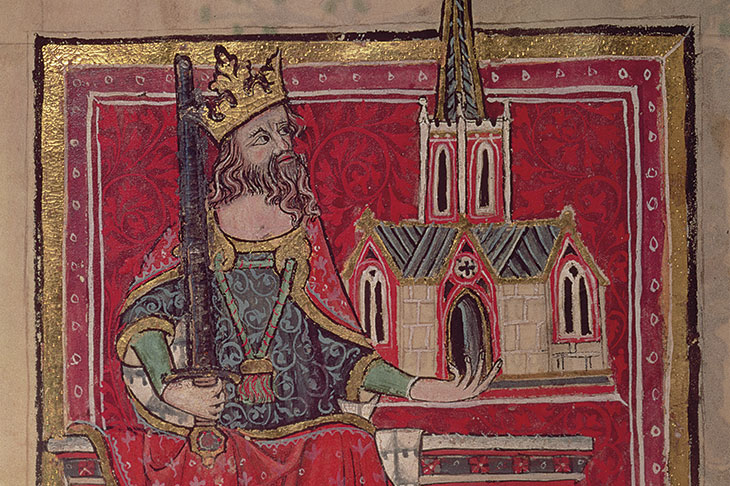The title of Marc Morris’s new history makes me want to get up and dance a little jig. The modern Inquisition has been jabbing its finger at the term ‘Anglo-Saxon’, accusing it of thought crime and threatening it with the cucking stool. (At least one august history society in the US has renamed itself in response.) Bad people have no doubt used the word, but Alfred the Great (871–99) and Æthelstan (924–39), among others, identified as such, and so contemporary historians have a reasonable case for using it too. Bravo Mr Morris for getting on with it. Having spent many years at academic conferences around the world, I can reassure readers that if today’s Anglo-Saxon scholars are closet white supremacists, their cover is pretty darn deep.
Undertaking a single-volume history of the Anglo-Saxon period is a sufficiently unmean feat that few have found the energy for it. Doing so requires an evaluation of some six centuries of British history — from the influx of German types at the end of Roman Britain c. 400 through to William the Conqueror’s rude arrival in 1066 — roughly the same length of time as from now back to the Battle of Agincourt. A lot happened, most of it unpredictable, obscured by the passage of time and the loss of primary sources.
Since the Anglo-Saxons at the outset lived in such a markedly different world to those at its close, one might ask whether they deserve to be considered together. The departure of Rome’s legions precipitated a catastrophe for which there is no parallel in British history. Late Roman Britain had towns built in stone, Christianity, writing, currency, hot water and central heating. Within a few generations, a ragtag of barbarous kingdoms occupied lowland Britain: the towns were empty, the gods were many, literacy had departed, there was no coinage and everyone was speaking Saxon and taking cold showers. By 1066, there was a highly centralized nation state called England with a single royal family, a regulated currency and a national church.
Finding the thread that runs through such a long and varied period is not easy, and those who have tried in the past have tended to do so with a purpose. Post-Conquest (and post-Reformation) churchmen looked to Anglo-Saxon England as a place of conversion, learning and almost prelapsarian piety. Mutton-chopped Victorians sought to establish it as the cradle of England’s manifest destiny as top nation. Such prisms being out of fashion, how now to approach the Anglo-Saxons?
Morris’s is ‘an account of the emergence of the English and the development of England’. This he delivers with gusto through the stories of vivid characters in consecutive periods, using their lives as windows on to a changing world. War-mongering ring-givers, pompous prelates with military retinues, dyke-building Mercians with grand designs, Viking-besieged ealdormen, filthy promiscuous juvenile kings — all are here in gay array. Cannily assembling his stories around the richest sources, Morris creates a highly engaging account in which, by degrees, the English and their kingdom emerge. This is top-notch narrative history, one that rests on an admirably au courant bibliography and is remarkably sure-footed on crumbly historiographical terrain.
A doyen of post-Conquest kings, Morris has an excellent feel for faction and nimbly picks his way around the complex court politics of the Anglo-Saxon aristocracy as it competed and combined like angry, amorous mink on heat. Different gangs of royals, toffs and bishops oust and eclipse one another as kings and their favorites grow old or die. Clergy build ecclesiastical empires through tickling patrons’ tummies or sucking up to their wives. Kings marry off sisters and daughters to neighbors and then find opportunities to take offense and invade.
Morris’s England is thus a nation of chancers — one that was bashed together in fits and starts by big men crashing into each other. This was undoubtedly true. Between the 7th century and the 10th, petty Anglo-Saxon kingdoms (Essex, Wessex, Sussex, Kent, Mercia, Deira, Bernicia, Elmet etc.) swallowed each other up until there was but one England ruled by the heirs of Alfred the Great. Such a tale can tend towards teleology, not least because it served the purposes of early medieval thinkers to present it that way. But the perennial spats, rebellions and invasions Morris describes made a centralized nation far from inevitable, causing, as they did, the partial disintegration of the kingdoms of Alfred’s son Edward the Elder (in 924), his grandson Æthelstan (in 939) and another grandson Eadwig (in 957). Moreover, the country became vulnerable as a result to the predations of prowling Danes — ultimately, in the reigns of Æthelred the Unready (d. 1016) and Edmund Ironside (d. 1016) to the point of conquest by Sweyn Forkbeard and his son Cnut.
Beneath the dangerous, bitchy inconstancies of court diplomacy, however, more stable foundations were being sunk. If the Anglo-Saxon Chronicles are to be believed, between 991 and 1018, Danish armies were paid 240,500 lb of silver. If this reveals the weakness of the Unready king, it is also indicates the strength of his kingdom. Large amounts of money, indeed vast sums, could be extracted from taxpayers very quickly.
This was because there was a highly regulated coinage, struck by royal command, which washed through every part of England. Archaeology allows us to calculate that by the 11th century tens of millions of coins were being produced and used by both high and low. (There is a story of a scribe who was offered payment in gold, silver, animals, wine or cash. ‘Count out the coins,’ he said.) From 973, under kingly supervision, every few years the currency was recalled, reminted and renewed. Such huge undertakings indicate effective coordination and central organization.
The Anglo-Saxon institutional legacy is, by any assessment, substantial. It bequeathed the monarchy, the currency, the shires, the towns, the law, and both the fact and the idea of England. Morris nods to these developments but does not always give them the recognition they deserve for building a remarkably sophisticated and resilient early medieval state that has lasted a millennium. That longevity requires explanation. King Edgar (d. 975) proclaimed that ‘every man, whether rich or poor, is to be entitled to the law, and just judgments are to be judged for him’. In his reign a huge system of very local courts, the hundred courts, based on subdivisions of shires, become visible. These could only function with the cooperation of large numbers of ordinary people participating in the workaday life of the kingdom. Theirs was the forum that provided law, taxes and men for war, and it was on them that rulers depended. This coupling of kings and common folk was durable indeed, a sort of hardwired social contract that was easily transferable to different ruling dynasties, enabling England to survive all manner of traumas.
Nevertheless, Morris has produced an impressive volume, a big gold bar of delight, the special joy of which is that the florid world of Anglo-Saxon England will become known to many. As an up-to-date, accessible narrative history of the period, I know of none better.
This article was originally published in The Spectator’s UK magazine. Subscribe to the World edition here.


















